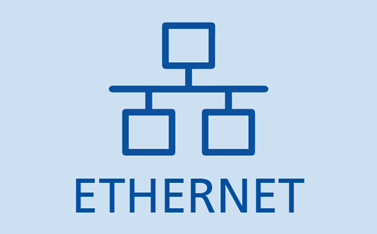In an era when RS232 ports were common, it was by far the most common method of bit-by-bit communication, so much so that the term “serial port” became synonymous with “RS232 port.” Using the word “serial” in conjunction adds to the confusion. Note that USB avoids this confusion, mainly because it is rarely called “Universal Serial Bus”.
In almost all cases, the logic level equivalent of an RS232 port will receive individual bytes from software and provide individual incoming bytes to software upon receipt. In contrast, most Ethernet devices will wait until software provides a complete packet (between 64 and 1536 bytes) before transmitting, and will wait until they have received and verified the entire packet before providing it for software use. Although bits and bytes may be sent serially over the wire, the software neither knows nor cares. It just knows that shortly after one controller receives a packet and is told to send it, the other controller will report that the packet is available and allow software to read it.
Make sure the “serial port” transmits byte data in the chronological order provided by the software, and feeds it to the software in the chronological order it was received. It would be useless if it didn’t. All Ethernet and Internet systems guarantee that when sending packets from one node to another, the number of bytes provided to the receiver will match the arrangement of bytes provided by the sender, but there is no common specification requirement The temporal order in which data is sent has nothing to do with its arrangement within the packet. Furthermore, the only guarantees about the chronological order of packets relative to each other are very vague. If packet X is delivered at 11:47 AM on Sunday, and packet Y is delivered at 3:28 PM the next day, it is safe to assume that Y was sent after X. On the other hand, if X is delivered at 1:47:12 and Y is delivered at 1:47:15, Y can be sent first, but X takes longer.

Ethernet can transmit serially, usually up to 1000BASE-T.
But it’s packed, so you can’t actually send a single valid byte because there’s a lot of addressing, crc, etc. overhead. Ethernet also doesn’t ensure ordering between packets, so you can send packets AB and C, but the receiver can get them in order CA B. Collision detection and retransmission are also introduced.
Overall, serial connections are much more complex.
OSI also represents this distinction.
The OSI protocol stack stands for Open Systems Interconnection (ISO is the International Organization for Standardization) and is a model that defines the structure used to transfer data between various devices. Each level is a different layer of abstraction and adds rules or details that define the communication protocol.
The Internet (excluding the common things associated with HTTP) belongs to the upper layer (network layer), and serial communication is just one way of defining the physical layer.
Compared to the TCP/IP model for the Internet, here’s the OSI model stack: You can see that the Internet is defined at the network level, while the serial protocol (strictly speaking, not the implementation) is defined by the physical layer, at The bottom of the stack.
Information about the Internet protocol suite from the Wiki:
The Internet Protocol Suite is a set of communication protocols used on the Internet and similar networks, and is generally the most popular protocol stack for wide area networks. Often called TCP/IP due to its most important protocols: Transmission Control Protocol (TCP) and Internet Protocol (IP)
It has four abstraction layers, each with its own protocol. From lowest to highest level they are:
● The link layer (usually Ethernet) contains the communication technology used in LANs.
● The Internet layer (IP) connects local networks, thereby establishing an Internet network.
● The transport layer (TCP) handles host-to-host communication.
● The application layer (eg HTTP) contains all the protocols for a specific data communication service at the process-to-process level (eg how a web browser communicates with a web server).
● Ethernet and WiFi are examples of protocols that can be used as a network access layer, providing the physical medium and basic transmission rules (such as symbol encoding) for Internet connections.
As mentioned above, other protocols used at different layers of the stack are TCP, UDP, HTTP and many others.
Palavras-chave: Terminal de transmissão de dados Ethernet industrial